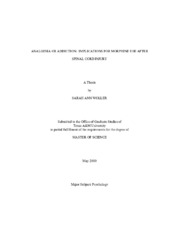| dc.description.abstract | Up to 65% of individuals with a spinal cord injury (SCI) experience neuropathic pain, and cite this as one of the most significant consequences of injury. Opiate analgesics are one of the most effective, but also most concerning, treatments for neuropathic pain. In fact, the use of morphine after SCI can potentiate the development of paradoxical pain symptoms, and continuous administration can lead to dependence, tolerance, and addiction. Empirical evidence suggests that the addictive potential of morphine decreases when used to treat neuropathic pain, but this has not been studied in an SCI model. These studies, therefore, aimed to investigate the addictive potential of morphine in a rodent model of spinal contusion injury. These experiments used a conditioned place preference (CPP) paradigm to examine whether subjects with SCI would develop a preference in the acute phase of injury, and whether a place preference would be expressed after the development of neuropathic pain symptoms in the chronic phase of injury. Results suggest that the time of treatment did affect the development of a preference for the morphine-paired context; subjects displayed a CPP in the acute, but not the chronic phase of SCI. In addition, the findings indicate that spinal neurons are sufficient, but not necessary, for producing a morphine-induced place preference. Overall, the results suggest that morphine could be used for the clinical treatment of neuropathic pain without concerns of addiction. Although SCI alone did not reduce the addictive potential of morphine in the acute phase of injury, the lack of preference in the chronic phase suggests that addiction may be reduced by molecular changes that accompany the development of neuropathic pain. Moreover, we hypothesize that the analgesic effects of morphine acting on spinal and peripheral mu-opioid receptors (MOR's) underlies the development of CPP in the acute phase of injury. This hypothesis is supported by the CPP established with intrathecal morphine administration. Nonetheless, the current studies cannot discount the role of supraspinally-mediated reward in the development of place preference after injury. Further work is needed to distinguish between the addictive and analgesic properties of morphine. | en |


